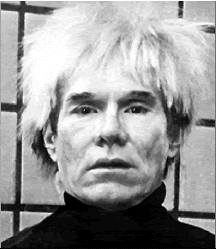Post by Ms. Kathy on Jan 14, 2005 14:41:53 GMT -6
Andy Warhol
albinism This autobiographical article came from
www.warholfoundation.org/

1928—87, American artist and filmmaker, b. Pittsburgh as Andrew Warhola. The leading exponent of the pop art movement, Warhol chose his imagery from the world of commonplace objects such as dollar bills, soup cans, soft-drink bottles, and soap-pad boxes. He is variously credited with attempting to ridicule and to celebrate American middle-class values by erasing the distinction between popular and high culture. Monotony and repetition became the hallmark of his multi-image, mass-produced silk-screen paintings: for many of these, such as the portraits of Marilyn Monroe and Jacqueline Kennedy, he employed newspaper photographs. He and his assistants worked out of a large New York studio dubbed the "Factory." In the mid-1960s Warhol began making films, suppressing the personal element in marathon essays on boredom. In The Chelsea Girls (1966), a seven-hour voyeuristic look into hotel rooms, he used projection techniques that constituted a startling divergence from established methods. Among his later films are Trash (1971) and L'Amour (1973). With Paul Morrissey, in 1974 Warhol also made the films Frankenstein and Dracula. In 1973, Warhol launched the magazine Interview, a publication centered upon his fascination with the cult of the celebrity. He died from complications following surgery. The Andy Warhol Museum, which exhibits many of his works, opened in Pittsburgh in 1994.
See his autobiographies (1969 and 1971). See also C. Ratcliff, Andy Warhol (1983); D. Bourdon, Warhol (1989); and V. Bockris, Life and Death of Andy Warhol (1989); W. Koestenbaum, Andy Warhol (2001).
The Andy Warhol Homepage is at www.warhol.dk/
Also see
www.lucidcafe.com/library/95aug/warhol.html
Interview 1964
Interview in Japan 1974
That's Why They Call it Art
Who Would You Rather Be?
Scenes from the Life of Andy Warhol 01-2 (1972)
albinism This autobiographical article came from
www.warholfoundation.org/

1928—87, American artist and filmmaker, b. Pittsburgh as Andrew Warhola. The leading exponent of the pop art movement, Warhol chose his imagery from the world of commonplace objects such as dollar bills, soup cans, soft-drink bottles, and soap-pad boxes. He is variously credited with attempting to ridicule and to celebrate American middle-class values by erasing the distinction between popular and high culture. Monotony and repetition became the hallmark of his multi-image, mass-produced silk-screen paintings: for many of these, such as the portraits of Marilyn Monroe and Jacqueline Kennedy, he employed newspaper photographs. He and his assistants worked out of a large New York studio dubbed the "Factory." In the mid-1960s Warhol began making films, suppressing the personal element in marathon essays on boredom. In The Chelsea Girls (1966), a seven-hour voyeuristic look into hotel rooms, he used projection techniques that constituted a startling divergence from established methods. Among his later films are Trash (1971) and L'Amour (1973). With Paul Morrissey, in 1974 Warhol also made the films Frankenstein and Dracula. In 1973, Warhol launched the magazine Interview, a publication centered upon his fascination with the cult of the celebrity. He died from complications following surgery. The Andy Warhol Museum, which exhibits many of his works, opened in Pittsburgh in 1994.
See his autobiographies (1969 and 1971). See also C. Ratcliff, Andy Warhol (1983); D. Bourdon, Warhol (1989); and V. Bockris, Life and Death of Andy Warhol (1989); W. Koestenbaum, Andy Warhol (2001).
The Andy Warhol Homepage is at www.warhol.dk/
Also see
www.lucidcafe.com/library/95aug/warhol.html
Interview 1964
Interview in Japan 1974
That's Why They Call it Art
Who Would You Rather Be?
Scenes from the Life of Andy Warhol 01-2 (1972)

